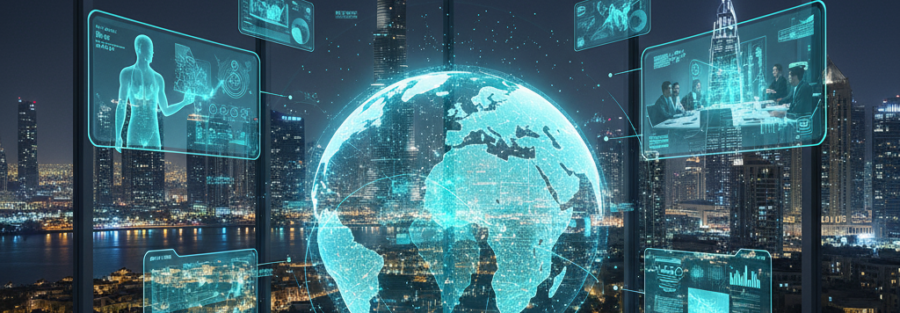Holographic Display Technology: The Future of Visual Communication
In recent years, digital screens have evolved far beyond simple LED and LCD displays. One of the most fascinating advancements capturing global attention is Holographic Display Technology — a technology that brings content to life with floating, three-dimensional visuals that appear to exist in mid-air. From advertising and retail to education, medical imaging, and events, holography is rapidly becoming a game-changer in the world of visual communication.
This blog explores what holographic display technology is, how it works, its top features, and the challenges it still faces.
What Is Holographic Display Technology?
Holographic display technology is a cutting-edge visual technique that creates 3D images, animations, or objects that appear to float freely in space without requiring special glasses or VR headsets. Unlike traditional 2D screens, holographic displays project light in a way that mimics how humans naturally perceive depth, allowing viewers to see different angles as they move around.
This effect is achieved using a combination of high-resolution projections, optical glass or mesh, LED or laser light, and advanced software. The result is an immersive, futuristic visual that feels almost real — making holography a powerful tool for brand engagement, demonstrations, and storytelling.
How Holographic Displays Work
Although different companies use different techniques, most holographic displays follow these core principles:
Light Projection – Video or 3D content is projected using LED, laser, or high-resolution projectors.
Optical Surface – A transparent reflection surface (glass, mesh, holographic foil) redirects the image into the viewer’s line of sight.
Depth Simulation – The system layers multiple images or creates angular variations to simulate depth.
Software Rendering – Specialized software controls angle, brightness, motion, and realism.
Together, these elements create the illusion of a live, floating 3D object.
Key Features of Holographic Display Technology
1. True 3D Visual Experience
Holographic displays offer natural depth, making visuals appear lifelike. Viewers can move around and observe different angles, unlike standard flat screens.
2. No Wearable Devices Needed
Unlike VR or AR, holography does not require headsets, glasses, or mobile devices. This makes it far more accessible in public and commercial environments.
3. High Engagement and Attention-Grabbing
The 3D floating effect captures attention instantly. This makes holographic displays highly effective for:
Retail store windows
Mall promotions
Product launches
Exhibitions and events
Museums and education displays
4. Transparent or Floating Visuals
Holographic content can appear on transparent glass or in the air using special foils. This creates futuristic visuals that enhance brand appeal.
5. Versatile Content Compatibility
Holographic displays can show videos, animations, rotating 3D models, and interactive content. For industries like automotive, medical, real estate, and fashion, this flexibility is invaluable.
6. Interactive Possibilities
Advanced systems support interactive touch or gesture control, allowing viewers to rotate objects, explore details, or trigger animations.
7. High Brightness and Clarity
Modern holographic displays are designed to remain bright even in well-lit environments. High contrast and vivid colors enhance realism.
8. Space-Saving Design
Many holographic setups require minimal physical space, making them suitable for tight retail areas or kiosks.
Applications Across Industries
Retail – Virtual product displays, mannequins, and promotional visuals.
Education – 3D models of organs, machines, historical artifacts, etc.
Healthcare – Medical imaging, surgery planning, anatomy visualization.
Real Estate – 3D walkthroughs of building layouts and interiors.
Events & Exhibitions – Product launches, stage performances, celebrity holograms.
Hospitality & Tourism – Virtual receptionists, guides, and interactive maps.
Drawbacks and Limitations
Despite its futuristic appeal, holographic display technology has a few challenges:
1. High Cost
Equipment, projection systems, and software are significantly more expensive than traditional digital signage. This limits adoption for small businesses.
2. Complex Setup and Calibration
Installing holographic displays requires precise angles, controlled lighting, and technical expertise. Poor alignment can reduce the 3D effect.
3. Limited Visibility in Outdoor Bright Light
Strong sunlight can wash out holographic visuals, making outdoor usage difficult without special setups.
4. Content Creation Is Time-Consuming
3D holographic content must be designed specifically for the display. This requires skilled designers and longer production times.
5. Viewing Angle Constraints
Some holographic systems have limited viewing zones. Outside those angles, the illusion of depth weakens.
6. Fragility of Equipment
Optical glass, foils, and projection systems can be delicate and require careful maintenance.
Conclusion
Holographic Display Technology is transforming how brands communicate, educate, and engage with audiences. Its ability to create mesmerizing 3D visuals without requiring any wearable devices makes it one of the most impactful innovations in the digital display industry.
While it comes with certain limitations — especially cost, setup complexity, and content creation challenges — its long-term potential is immense. As the technology evolves and becomes more affordable, holography will likely become a mainstream solution across retail, education, healthcare, and entertainment.



